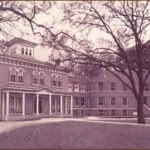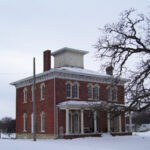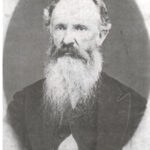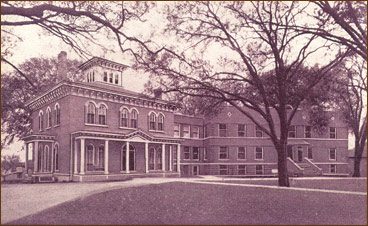
The Capt. Daniel S. and Fannie L. (Brooks) Lee Mansion located in the 800 block of First Street East in Independence, Iowa, is a classic example of the Italianate Style and is locally significant. Its simple square form and symmetrical proportions speak of a formal, yet gracious, style of living. The Italianate Style is well represented in Independence but the surviving structures are usually constructed of wood and are also more elaborate in design. Only the Lee Mansion and the residence section of the Seeland Brewery exhibit brick construction in a symmetrical square plan.
The Lee Mansion was built in 1867 using soft brick laid in a running bond style on a native limestone block foundation. A course of smooth cut limestone separates the foundation from the brick walls. All doors and windows feature sills and arched lintels of this same cut and smoothed limestone. Each lintel is composed of two half arch pieces and a projecting keystone. The two story walls are capped with a medium pitched simple hipped roof and a belvedere. Three chimneys protrude from the roof but interior evidence indicates there were originally four. A heavily bracketed soffit completely surrounds the top of the brick walls and the top of the belvedere.
In 1917 the house became the home of the Peoples Memorial Hospital. Additions constructed in 1923, 1930, 1950, and 1957 connected to and completely covered the west face of the Lee Mansion. These additions have been demolished by the City of Independence, the current owner of that portion of the property.
The north or front lawn is filled with eleven mature burr oak trees flanking a sidewalk which leads straight to First Street East and compliments the symmetry of the building. The east lawn has been filled with a parking lot which served the hospital. The land directly to the West is now the home of the new Independence Public Library. It mirrors the Lee Mansion and displays the horse weathervane that was once on top of the famous Rush Park Show Barn West of Independence.
The front facade of the building features a masonry and cement porch across its entire width. A wooden hatch on the west end of the porch floor covered the coal chute which leads into the basement. The porch roof is supported by square paneled columns with molded capitals. Paired windows which extend to the level of the porch floor flank a double door of oak with heavy moldings and brass hinges. The fan light above the door is of etched glass. The second floor has three pairs of windows with higher sills directly above the windows and doors on the first floor. All windows are fitted with double hung sashes with a variety of light divisions which seem to depend on the size of the sashes.
The east face of the building has the same arrangement as the front except the windows and door are not in pairs. The shadow of a small side porch is evident on the brickwork surrounding the door in the middle of the first floor (currently covered with plywood sheeting) on this side of the building. There is also a corresponding gap in the limestone course that divides the limestone and brick portions of the walls which could accommodate a porch floor.
The windows on the south face of the building mimic the north face except the double door is replaced with a single window whose sill has been raised, and the resulting space filled with plywood) and the eastern most aperture contains a door instead of a window. Here again there is a gap in the limestone dividing course which could indicate a porch which extended across the complete width of the building. Directly below the central window there is a bulkhead and an exterior stair into the basement. The placement of this stairway would seem to conflict with the existence of a porch in this location and there are no scars on the walls to indicate a porch roof. It is possible the door on this side was reached by a flight of stairs which are long gone and the dividing course on the walls was considered an unnecessary feature for the back of the house. There is no access to the basement from the interior of the house, but recently found plans indicate that there could have been.
The west face of the building was updatd in 2016 and now four windows replace the bricked up walls.
The interior of the house is remarkably intact considering its history as a hospital. This is confirmed by recently discovered drawings by Harry E. Netcott and A.M Donnan, the architects involved with the initial conversion for hospital use. These drawings are held by the Buchanan County Historical Society.
Upon entering the front door, one is confronted with a spacious hallway which extends to the rear of the house. The north/south interior walls are masonry while the east/west walls are of frame construction. The south end of this remodeled into a handicap restroom. This bath contains the south face window with the raised sill and no doubt was the reason for the alteration. An open stair with a prominent newel post and banister rises on the east wall to provide access to the second story. The banister is most likely made of walnut while the interior woodwork appears to be of clear pine. All of the interior woodwork has been painted.
In the northeast corner of the first floor is a room which could have functioned as a dining room. This room has a boxed chimney which certainly once featured a fireplace. Passageways connect to the southeast room which most likely was the kitchen. There is a narrow chimney in this room which could easily accommodate a stove. On the west side of the central hall are two rooms connected by a large open doorway. These rooms could have originally been a formal dining room and a front parlor. The connecting doorway contained pocket doors which were replaced in 2019. Both of these rooms retain fireplaces with slate mantelpieces. The one in the north room has been painted (and recently been stripped) with the woodwork, but the one in the south room retains the remnants of its original faux finish. These mantels are made of slate which was then painted to resemble marble. All of the ceilings in the rooms on the first floor were lowered to the upper edge of the window casings, and just recently have been removed.
The second floor rooms are arranged much like those on the first floor. All four chimneys are evident but there are no fireplaces. These could easily accommodated stoves as a heat source in the upstairs rooms if the gas fired steam heating system is not original. At the south end of the hall, lift top cupboards fill the wall below the paired windows. There is a small room at the north end of the hall which contains the only unpainted woodwork in the house.
The north and south rooms on the west side of the hall are of equal size and a shallow closet for each room has been sandwiched between them. The southwest room is now full of early medical equipment donated throughout the years by fromer doctors of Buchanan Co. and People’s Memorial Hospital. It is now renamed “Dr. Office.” The northwest room has been remodeled into a Civil War Room with artifacts. The northeast room is much the same as the west rooms and has a narrow closet in the southwest corner. The southeast quadrant is divided into a small room in the corner, a short hallway connecting to the north room and an enclosed stairway which extends to the attic and on to the belvedere. The ceilings of the hallway and the two north rooms are covered with ornamental embossed metal squares.
In the attic the tops of the interior masonry walls are visible. The structural beams have been shaped by hand instead of sawn in a mill. The fitted joints between the various elements of the framing are secured with wooden pins. Three wooden casement windows are located on each wall of the belvedere. The window frames of six lights (with the upper two lights forming an arched top) are hinged on one side and swing inward. Exterior shutters cover these windows and they are hinged to swing outward
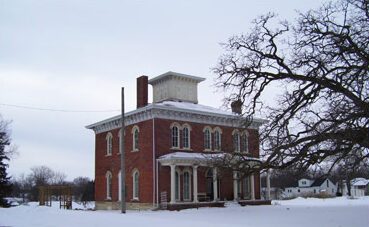
The Capt. Daniel S. and Fannie L. (Brooks) Lee Mansion and the land directly under it are owned by the Buchanan Co. Historical Society. Renovation continues as funding permits. When completed, it will be furnished with pieces from the Society’s collection and opened as a house museum and meeting facility.
Capt. Lee was a prominent early settler in Independence. He was born on October 16, 1817, in Genesee County, New York. Following the death of his mother, the family was broken up and Capt. Lee was supporting himself by the time he was 16 years old. He worked on area farms during the growing season and attended school in the winter months. He left Genesee County in 1842 with $22 and all his belongings in a small hand satchel.
Lee made his way to Akron, Ohio, by way of Buffalo, New York, and Cleveland, Ohio. His resources being greatly reduced, he advertised for students and opened a school. For the next four and one half years he also studied the law with the Hon. William C. Dodge. He was admitted to the bar in the Fall of 1846 and opened his own office in Akron, Ohio, in 1847.
He and the former Fannie L. Brooks were married in Northfield, Ohio, in 1850. Fannie Brooks Lee was born on March 12, 1828, in Bethel, Vermont. At the age of 6 years, she moved with her parents, Mr. And Mrs. P.A. Brooks, to Summit County, Ohio, where she lived until her marriage.
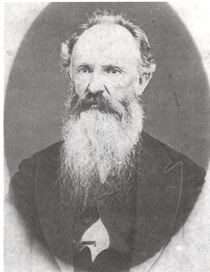
In 1851, the Hon. D.S.Lee headed west in search of brighter prospects. He arrived in Dubuque, Iowa, where he stayed for several months teaching school and studying the law. He was admitted to the bar of the Iowa Supreme Court in 1852. He again headed west and arrived in Independence. Due to high water in the Wapsipinicon River, he was delayed for two weeks and during that time, he decided to stay in the young city. He was the first professional lawyer in Independence and also served as land agent for a company based in Dubuque.
Mr. Lee promptly requested his wife join him in their new home. In 1852, he was elected to the office of prosecuting attorney. In 1854, Mrs. Lee’s parents and siblings followed them to Independence. In the middle 1850’s he helped organize the first bank with partners P.E. and E.B. Older. This was a prosperous venture until the Panic of 1857 when the bank was wiped out. In 1858, Lee helped organize the Buchanan County Agricultural Society which was responsible for holding early county fairs. Mr. Lee helped draft the constitution. At the first exhibition produced by this society, Lee won the prizes of $4.00 for the best breeding mares and $5.00 for the best stallion, 5 years and older. Both Lees served on committees which organized the 4th of July celebration in 1860. The purpose of the event was to raise money to purchase a bell for the town of Independence.
With the beginning of the “War of the Rebellion”, Daniel Lee made a rousing patriotic speech at a mass meeting at the county court house in Independence. He ended the speech by becoming the first volunteer from Buchanan County. He helped raise a company of men which eventually became Company E assigned to the 5th Regiment Iowa Volunteers. On June 1, 1861, Lee was elected to the rank of captain. Mrs. Lee was also involved in the effort. On October 25th the same year, she was elected to the office of president of a soldier’s aid society in Independence.
During his three years of service, Capt. Lee proved to be a very capable officer. He served under General Fremont in Missouri, and under Gen. Grant for several battles leading up the siege of Vicksburg. Capt. Lee transferred to the Army of the Gulf and was on the staff of Gen. Charles L. Matthies for eight months before mustering out of the service in August of 1864.
Capt. Lee returned to a newly incorporated Independence and was the first person elected to fill the office of Mayor. He served for one and one half terms before resigning to devote all of his time to personal business pursuits. In 1867, Capt. and Mrs. Lee moved into their new residence constructed on property at the east edge of town. Capt. Lee continued his political career in 1869 when he was elected to the office of Representative to the Iowa State Legislature. He held this office through the 13th Assembly. The Lees continued to be active in the social events of Independence during their later years. In 1877, Capt. Lee became a charter member of the Early Settler’s Association of Buchanan Co., Iowa.
For several years preceding his death in 1878, Capt. Lee suffered steadily declining health. He died at the home of his brother-in-law, Charles Brooks, on May 25th, of a condition described as “softening of the brain”. Capt. Lee was memorialized in the Buchanan County History of 1881 as being of “medium height, straight as an arrow, with a well developed head, and was a strikingly handsome man, easy and graceful in every movement, affable and kind.” Mrs. Lee remained at her brother’s home for several years before returning to her home on First Street East in Independence.
Fannie L. Lee began experiencing declining health early in the new century. By January 1904, Mrs. Lee, her brothers, Charles Brooks and George Brooks, and her sister and brother-in-law, Harriet and A.P. Barber, had entered into an agreement to provide for the management of Mrs. Lee’s affairs. Fannie L. Brooks Lee died at her home in Independence in the fall of 1904. The funeral was conducted several days later at the Lee Home. Mrs. Lee was buried with her husband in Oakwood Cemetery in Independence, Iowa.
Harriet and Asa P. Barber inherited the Lee Mansion and the surrounding acres of land. George Brooks retained the right to remove the barn he had constructed on the property. In 1913, the Barbers sold the property to Leonora and George Blamer, who eventually sold the house and a little over two acres of land to the newly organized Peoples Hospital in 1917.
Peoples Hospital was the first modern hospital in Independence. It replaced a collection of facilities provided by individual physicians and other private citizens. As the needs of the community grew, the hospital was enlarged in 1923, 1930, 1950, and 1957. These additions completely covered the west side of the Lee Mansion. When a new hospital facility was built in 1968, the “old hospital” became a long term care unit known as Peoples Nursing Care Center. As years passed, the Lee House portion of the building was used less and less. It finally was used only for storage. In the 1990’s the care center was moved into a new wing at the hospital building. The old building was no longer needed and the Peoples Memorial Hospital Board of Trustees deeded the building and land back to the Buchanan County Supervisors.
In 1993 the Buchanan County Supervisors divided the property between the Buchanan County Historical Society (BCHS) and Operation Threshold, Inc., of Waterloo, Iowa. In the agreement worked out between all parties, BCHS became the owners of the portion of the building which was the original Lee residence and the land directly under the building. Operation Threshold, Inc., took possession of the 2.17 acres which was the remainder of the original Lee parcel and the later additions of the hospital building. Operation Threshold, Inc., planned to adapt the building to provide low income housing units. Funding for this project was not forthcoming and Operation Threshold, Inc., eventually deeded their portion of the property back to Buchanan Co.
In order to obtain control of this large parcel of land uniquely situated in a main residential area, the City of Independence notified the Buchanan County Supervisors of the City’s interest in the property. Early in 1994 the City and County made an agreement and the City of Independence became the owner of the parcel which Operation Threshold., Inc., had previously held. BCHS retains ownership of the parcel which is in effect the Lee Mansion. The City demolished the additions made to the Lee Mansion. BCHS is renovating the building as funds permits.
Attached Images

